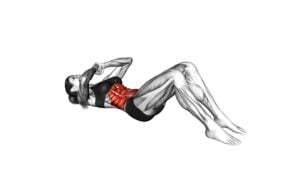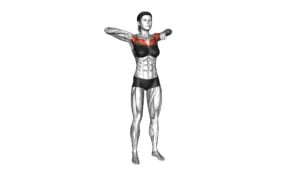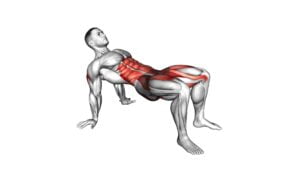Elbow to Knee Sit up – Video Exercise Guide & Tips

Get ready to level up your core workout with the elbow to knee sit up! This video exercise guide will show you the proper form and technique to maximize your results.
Watch This Exercise Video
Don't worry about making common mistakes – we've got tips to help you avoid them.
Beginners can modify the exercise to suit their fitness level, while those looking for a challenge can find tips to increase difficulty.
Get ready to incorporate this dynamic move into your workout routine and see those abs start to pop!
Key Takeaways
- Engages multiple muscle groups simultaneously
- Improves core stability and strength
- Targets abdominal muscles, hip flexors, and obliques
- Enhances overall physical performance
Benefits of the Elbow to Knee Sit up
To achieve a stronger core and improve abdominal strength, incorporate the Elbow to Knee Sit up into your workout routine. This exercise offers a wide range of benefits that can enhance your overall fitness level. One of the main advantages of the Elbow to Knee Sit up is its ability to engage multiple muscle groups simultaneously.
As you perform the sit up, your abdominal muscles, hip flexors, and obliques are all activated, leading to improved core stability and strength. Additionally, this exercise also targets your lower back muscles, helping to improve posture and prevent lower back pain.
Breathing techniques play an important role in maximizing the benefits of the Elbow to Knee Sit up. As you lift your upper body off the ground, exhale forcefully to engage your core muscles and generate more power. Inhale as you lower yourself back down to the starting position, allowing your abdominal muscles to relax. This controlled breathing pattern helps to stabilize your core and maintain proper form throughout the exercise.
For beginners or those with limited core strength, modifications can be made to make the Elbow to Knee Sit up more accessible. One modification is to perform the exercise with bent knees instead of straight legs. This reduces the demand on your abdominal muscles and makes it easier to execute the movement. Gradually progress to straight legs as your core strength improves.
Incorporating the Elbow to Knee Sit up into your workout routine can yield significant results in terms of core strength and abdominal development. By utilizing proper breathing techniques and making modifications for beginners, you can safely and effectively challenge your core muscles and achieve a stronger, more defined midsection.
Proper Form and Technique
To maximize the benefits of the elbow to knee sit up, it's crucial to focus on proper form and technique. By maintaining a strong core, engaging your abs, and keeping your back straight throughout the movement, you can effectively target your abdominal muscles.
Avoid common mistakes such as using momentum or pulling on your neck, and instead, concentrate on controlled movements to achieve optimal results.
Benefits of Proper Form
Achieving proper form during the elbow to knee sit-up exercise offers numerous benefits for your overall strength and core stability. By maintaining the correct technique, you can significantly improve your core strength, which is essential for a strong and stable midsection.
The elbow to knee sit-up engages multiple muscles, including the abdominals, obliques, and hip flexors, helping to develop a strong and defined core. Additionally, proper form during this exercise helps prevent injuries. When you perform the movement correctly, you reduce the risk of straining your neck or lower back, ensuring a safe and effective workout.
So, focus on maintaining a straight back, engaging your core muscles, and keeping your movements controlled. By prioritizing proper form, you can maximize your results and minimize the risk of injury.
Keep pushing yourself and enjoy the benefits of a strong and stable core.
Common Technique Mistakes
Maintaining proper form and technique is crucial to avoid common mistakes during the elbow to knee sit-up exercise.
One common technique error is using momentum to power through the movement instead of relying on your abdominal muscles. To fix this mistake, focus on initiating the movement from your core and avoid using your arms or legs to assist you.
Another common mistake is rounding the back during the sit-up, which puts unnecessary strain on the spine. To correct this, keep your back straight and engage your core muscles to lift your upper body off the ground.
By paying attention to these technique mistakes and making the necessary adjustments, you can maximize the effectiveness of the elbow to knee sit-up exercise and minimize the risk of injury.
Now, let's move on to the next section to learn about common mistakes to avoid.
Common Mistakes to Avoid
When performing the elbow to knee sit up, it's crucial to pay attention to proper form to maximize results and avoid injury. A common mistake to avoid isn't demonstrating the correct form from the start.
Remember to engage your core and exhale as you lift your upper body, ensuring you're using your abdominal muscles and not relying on momentum.
Proper Form Demonstration
To perform the Elbow to Knee Sit up with proper form and avoid common mistakes, you should keep your core engaged throughout the movement. This means tightening your abdominal muscles and maintaining a strong and stable core throughout the exercise. By doing so, you'll ensure that you're targeting the correct muscles and maximizing the effectiveness of the exercise.
Additionally, it's important to be aware of variations for advanced practitioners. Once you have mastered the basic form of the Elbow to Knee Sit up, you can try adding weights or using a stability ball to increase the challenge. However, it's crucial to always prioritize safety and take precautions.
Make sure to warm up properly, listen to your body, and avoid any movements or positions that cause pain or discomfort. Stay focused and stay safe as you work towards strengthening your core.
Breathing Techniques Importance
To ensure proper form and maximize the effectiveness of the Elbow to Knee Sit up, it's crucial to understand the importance of breathing techniques and avoid common mistakes. Proper breathing techniques not only enhance your performance during the exercise but also offer a range of benefits for your overall well-being.
Here are some key benefits of incorporating proper breathing techniques into your Elbow to Knee Sit up routine:
- Increased oxygen intake: Deep breaths allow you to take in more oxygen, providing fuel for your muscles and boosting your energy levels.
- Enhanced core engagement: Focusing on your breath helps you engage your core muscles more effectively, making your sit-ups more efficient.
- Reduced stress and tension: Deep breathing can help relax your body and mind, reducing stress and tension.
- Improved mind-body connection: Paying attention to your breath can help you stay present in the moment, improving your mind-body connection and overall focus.
Benefits of Correct Execution
To achieve optimal results and avoid common mistakes, it's important to understand the benefits of executing the Elbow to Knee Sit up correctly. One of the main benefits is the development of core strength. This exercise targets the abdominal muscles, obliques, and hip flexors, helping to strengthen and tone these areas. Having a strong core not only improves your posture and stability but also enhances your overall physical performance in other activities.
Another benefit is the ability to progress to advanced variations. Once you have mastered the basic Elbow to Knee Sit up, you can challenge yourself by incorporating different variations. For advanced exercisers, you can try adding weights, increasing the speed of the movement, or even performing the exercise on an unstable surface like a stability ball or balance board. These variations provide an extra challenge and help to further improve your core strength and stability.
By understanding the benefits of correct execution and utilizing advanced variations, you can continue to challenge yourself and make progress in your fitness journey.
Now let's explore some modifications for beginners to help them get started on their Elbow to Knee Sit up routine.
Modifications for Beginners
You can gradually build strength and improve your form by frequently incorporating modifications into your elbow to knee sit up routine. Here are some beginner modifications and alternative exercises to help you get started:
- Assisted elbow to knee sit ups: If you're struggling to complete the full range of motion, you can have a partner hold your feet down or use a stability ball to support your lower back.
- Knee tucks: This exercise is a great alternative for beginners as it reduces the strain on your core. Simply lie on your back, bring your knees towards your chest, and then slowly lower them back down.
- Seated Russian twists: Sit on the floor with your knees bent and feet flat. Hold a weight or medicine ball in front of you, and then twist your torso from side to side, tapping the weight on the floor each time.
- Dead bug exercise: Lie on your back with your arms extended towards the ceiling and your knees bent at a 90-degree angle. Slowly lower one arm and the opposite leg towards the floor, and then return to the starting position. Alternate sides.
By incorporating these modifications and alternative exercises, you can gradually build strength and improve your form.
Once you feel comfortable with these beginner modifications, you can move on to the tips for increasing difficulty.
Tips for Increasing Difficulty
To challenge yourself further and enhance the intensity of your elbow to knee sit-up routine, try incorporating the following tips.
First, you can increase the intensity by adding resistance. Hold a dumbbell or a weighted plate against your chest while performing the sit-up. This will engage your core muscles even more, making the exercise harder and more effective.
Another way to increase the difficulty is by adding progressions to your routine. Start by performing regular elbow to knee sit-ups, but as you get stronger, you can progress to more advanced variations. For example, you can try doing bicycle crunches, where you alternate bringing your elbow to the opposite knee while extending the other leg. This variation targets not only your abs but also your obliques, giving you a more challenging workout.
You can also try incorporating variations in the speed and tempo of your sit-ups. Slow down the movement and focus on engaging your core muscles throughout the entire range of motion. Alternatively, you can speed up the pace, performing quick and explosive sit-ups to add a cardiovascular element to your routine.
Remember to listen to your body and progress at a pace that feels challenging but still manageable. Pushing yourself to increase intensity and incorporate progressions and variations will help you continually improve your strength and fitness levels.
Keep up the hard work and enjoy the results!
Incorporating the Elbow to Knee Sit up Into Your Workout Routine
As you incorporate the elbow to knee sit up into your workout routine, consider different ways to challenge yourself and make the exercise more effective. By incorporating core exercises and variations of sit ups, you can target different muscles in your abdominal region and enhance your overall fitness level. Here are some ideas to help you get started:
- Mountain Climber Sit Ups: Combine the elbow to knee sit up with mountain climbers to engage your core and increase your heart rate. Start in a plank position, perform a mountain climber, then transition into a sit up, bringing your elbow to your opposite knee. Alternate sides and repeat for a challenging full-body workout.
- Weighted Elbow to Knee Sit Ups: Hold a dumbbell or kettlebell at your chest while performing the sit up. The added resistance will intensify the exercise and help build strength in your abdominal muscles.
- Decline Elbow to Knee Sit Ups: Perform the sit up on a declined bench or stability ball to increase the difficulty and engage your core even more. The decline position forces your abdominal muscles to work harder to stabilize your body.
- Twisting Elbow to Knee Sit Ups: Add a twist to the sit up by reaching your opposite elbow towards your knee as you come up. This variation targets your obliques and adds an extra challenge to your workout.
Incorporating these variations into your elbow to knee sit up routine won't only keep your workouts exciting but also help you achieve a stronger and more defined core. Remember to listen to your body and progress at a pace that feels comfortable yet challenging. Keep pushing yourself, and you'll see the results you desire.
Frequently Asked Questions
How Many Reps and Sets Should I Do of the Elbow to Knee Sit Up?
To determine how many reps and sets you should do of the elbow to knee sit up, consider your fitness level and goals.
Start with 2-3 sets of 10-12 reps and gradually increase as you get stronger.
This exercise targets your core muscles and can be modified for beginners by keeping your knees bent or using a stability ball.
Incorporating the elbow to knee sit up into your routine can improve core strength and stability, leading to better overall fitness.
Stay motivated and keep pushing yourself!
Can I Perform the Elbow to Knee Sit up if I Have Lower Back Pain?
If you're dealing with lower back pain, there are modifications you can make to the elbow to knee sit up exercise. Focus on keeping your core engaged and your movements controlled.
Instead of bringing your elbow all the way to your knee, try bringing it halfway or even just lifting your shoulder off the ground.
If the exercise is still too challenging, there are alternative exercises like planks or bird dogs that can help strengthen your core without aggravating your lower back pain.
Stay motivated and listen to your body!
Is the Elbow to Knee Sit up Suitable for Pregnant Women?
During pregnancy, it's important to find exercises that are safe and beneficial for you and your baby.
The elbow to knee sit up can be a suitable exercise for pregnant women, as it helps strengthen your core and improve overall stability. However, it's crucial to modify the exercise to accommodate your growing belly.
Instead of lifting your upper body all the way to your knees, focus on engaging your core and doing smaller movements.
Always listen to your body and consult with your healthcare provider before starting any new exercise routine.
What Is the Recommended Rest Time Between Sets of the Elbow to Knee Sit Up?
To maximize your results and prevent injury, it's important to know the recommended rest time between sets of the elbow to knee sit up. This will allow your muscles to recover and prepare for the next set.
Additionally, incorporating proper form tips will help you engage the correct muscles and avoid unnecessary strain.
Can I Perform the Elbow to Knee Sit up Without a Mat or on a Hard Surface?
Yes, you can perform the elbow to knee sit up without a mat or on a hard surface. While it's generally recommended to use a mat for added comfort and support, you can still do this exercise on a hard surface. However, be cautious and ensure you maintain proper form to avoid any discomfort or strain.
If you prefer alternatives to the elbow to knee sit up that can be done without a mat or on a hard surface, try exercises like Russian twists or bicycle crunches.
Conclusion
Incorporating the elbow to knee sit up into your workout routine can provide numerous benefits, including strengthening your core muscles and improving your overall fitness level. By following proper form and technique, avoiding common mistakes, and making necessary modifications, you can effectively perform this exercise.
Additionally, as you progress, you can increase the difficulty of the elbow to knee sit up to challenge your body even more. So, get ready to take your fitness journey to the next level with this dynamic exercise. Keep pushing yourself and enjoy the results!

Author
Years ago, the spark of my life’s passion ignited in my mind the moment I stepped into the local gym for the first time. The inaugural bead of perspiration, the initial endeavor, the very first surge of endorphins, and a sense of pride that washed over me post-workout marked the beginning of my deep-seated interest in strength sports, fitness, and sports nutrition. This very curiosity blossomed rapidly into a profound fascination, propelling me to earn a Master’s degree in Physical Education from the Academy of Physical Education in Krakow, followed by a Sports Manager diploma from the Jagiellonian University. My journey of growth led me to gain more specialized qualifications, such as being a certified personal trainer with a focus on sports dietetics, a lifeguard, and an instructor for wellness and corrective gymnastics. Theoretical knowledge paired seamlessly with practical experience, reinforcing my belief that the transformation of individuals under my guidance was also a reflection of my personal growth. This belief holds true even today. Each day, I strive to push the boundaries and explore new realms. These realms gently elevate me to greater heights. The unique combination of passion for my field and the continuous quest for growth fuels my drive to break new ground.







